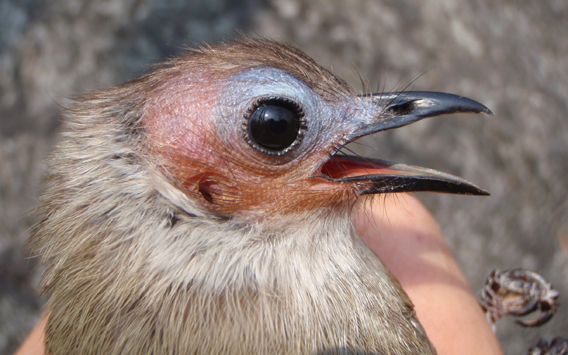Researchers have discovered a bald species of songbird in a remote part of Laos, reports the Wildlife Conservation Society. The “Bare-faced Bulbul” is the first new species of bulbul – a family of about 130 species – described in Asia in over 100 years.
The greenish-olive bird is characterized by its featherless, pink face and bluish skin around the eye. A team of scientists from WCS and the University of Melbourne discovered the species as part of a project funded and managed by Minerals and Metals Group (MG), a mining company that operates the Sepon copper and gold project in the region.
“It’s always exciting to discover a new species, but this one is especially unique because it is the only bald songbird in Asia,” said Colin Poole, director of Asia programs for the Wildlife Conservation Society. “The discovery also underscores how much there is still to learn from wild places around the world.”
 Photo credit: Iain Woxvold/University of Melbourne |
The bird was found living in trees growing on rugged limestone karsts between between the Phou Xang He and Hin Namno National Protected Areas in southern Laos.
“Its apparent restriction to rather inhospitable habitat helps to explain why such an extraordinary bird with conspicuous habits and a distinctive call has remained unnoticed for so long,” said the University of Melbourne’s Iain Woxvold, co-author of the bird’s description, which is published in the July issue of the Oriental Bird Club’s journal Forktail. Authors include Will Duckworth and Rob Timmins of WCS.
The discovery occurred in the same area where Timmins first described a previously unknown species of striped rabbit and the kha-nyou, a species of rodent so unusual it represented the lone surviving member of an otherwise extinct genus. Earlier this year scientists announced the discovery of another previously unknown, karst-dwelling bird, the Nonggang Babbler (Stachyris nonggangensis), in China’s Guangxi province near the border with Vietnam.
Karst ecosystems
With a variety of habitats including sinkholes, caves, cliffs, and underground rivers, and separated from other outcroppings by lowland areas, karsts support high levels of endemism among insects, snails, fish, plants, bats and other small mammals. Animals that inhabit karsts provide humans with important services including pest control, pollination, and a sustainable source of income (swiftlet nests used for bird nest soup, a Chinese delicacy, are found in karst caves). But karsts are increasingly under threat, especially from mining for cement and marble. An earlier study by Clements showed that limestone quarrying is increasing in Southeast Asia by 5.7 percent a year — the highest rate in the world — to fuel the region’s construction boom. The biodiversity of karsts — especially among animals that move to surrounding areas to feed — is also at risk from destruction of adjacent ecosystems, often by loggers or for agriculture.
I. A. Woxvold, J. W. Duckworth and R. J. Timmins. An unusual new bulbul (Passeriformes: Pycnonotidae) from the Limestone karst of Lao PDR. Forktail July 2009.